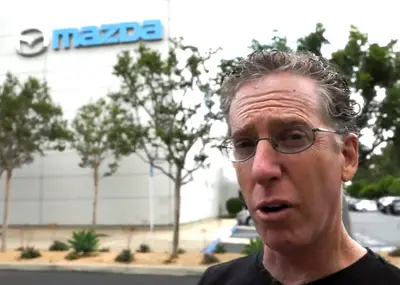Fireball Tim Goes Inside Mazda's Top Secret Design Studio +VIDEO
 |
HOLLYWOOD USA - April 26, 2015: In this episode of Fireball Tim's new VLOG series, Fireball heads inside Mazda's Top Secret Design Center, thanks to Chief Designer DEREK JENKINS... then has pizza. Yea!
History of Mazda
Mazda began as the Toyo Cork Kogyo Co., Ltd, founded in Hiroshima, Japan in 1920. Toyo Cork Kogyo renamed itself
to Toyo Kogyo Co., Ltd. in 1927. In the late 1920s the company had to be saved from bankruptcy by Hiroshima Saving
Bank and other business leaders in Hiroshima.
In 1931 Toyo Kogyo moved from manufacturing machine tools to vehicles with the introduction of the Mazda-Go autorickshaw. Toyo Kogyo produced weapons for the Japanese military throughout the Second World War, most notably the series 30 through 35 Type 99 rifle. The company formally adopted the Mazda name in 1984, though every automobile sold from the beginning bore that name. The Mazda R360 was introduced in 1960, followed by the Mazda Carol in 1962.
Beginning in the 1960s, Mazda was inspired by the NSU Ro 80, and decided to put a major engineering effort into development of the Wankel rotary engine as a way of differentiating itself from other Japanese auto companies. The company formed a business relationship with German company NSU, and began with the limited-production Cosmo Sport of 1967 and continuing to the present day with the Pro Mazda Championship, Mazda has become the sole manufacturer of Wankel-type engines for the automotive market mainly by way of attrition (NSU and CitroŽn both gave up on the design during the 1970s, and prototype Corvette efforts by General Motors never made it to production.)
This effort to bring attention to itself apparently helped, as Mazda rapidly began to export its vehicles. Both piston-powered and rotary-powered models made their way around the world. The rotary models quickly became popular for their combination of good power and light weight when compared to piston-engined competitors that required heavier V6 or V8 engines to produce the same power. The R100 and the RX series (RX-2, RX-3, and RX-4) led the company's export efforts.
During 1968, Mazda started formal operations in Canada (MazdaCanada) although Mazdas were seen in Canada as early as 1959. In 1970, Mazda formally entered the American market (Mazda North American Operations) and was very successful there, going so far as to create the Mazda Rotary Pickup (based on the conventional piston-powered B-Series model) solely for North American buyers. To this day, Mazda remains the only automaker to have produced a Wankel-powered pickup truck. Additionally, it is also the only marque to have ever offered a rotary-powered bus (the Mazda Parkway, offered only in Japan) or station wagon (within the RX-3 & RX-4 line for US markets). After nine years of development, Mazda finally launched its new model in the U.S. in 1970.
Mazda's rotary success continued until the onset of the 1973 oil crisis. As American buyers (as well as those in other nations) quickly turned to vehicles with better fuel efficiency, the relatively thirsty rotary-powered models began to fall out of favor.
Combined with being the least-efficient automaker in Japan (in terms of productivity), inability to adjust to excess inventory and over-reliance on the U.S. market, the company suffered a huge loss in 1975.[10] An already heavily indebted Toyo Kogyo was on the verge of bankruptcy and was only saved through the intervention of Sumitomo keiretsu group, namely Sumitomo Bank, and the companies subcontractors and distributors.
Fortunately, the company had not totally turned its back on piston engines, as it continued to produce a variety of four-cylinder models throughout the 1970s. The smaller Familia line in particular became very important to Mazda's worldwide sales after 1973, as did the somewhat larger Capella series.
Mazda refocused its efforts and made the rotary engine a choice for the sporting motorist rather than a mainstream powerplant. Starting with the lightweight RX-7 in 1978 and continuing with the modern RX-8, Mazda has continued its dedication to this unique powerplant. This switch in focus also resulted in the development of another lightweight sports car, the piston-powered Mazda Roadster (perhaps better known by its worldwide names as the MX-5 or Miata), inspired by the concept 'jinba ittai'. Introduced in 1989 to worldwide acclaim, the Roadster has been widely credited with reviving the concept of the small sports car after its decline in the late 1970s.
Discover loads more of Fireball's reviews and videos by CLICKING HERE


